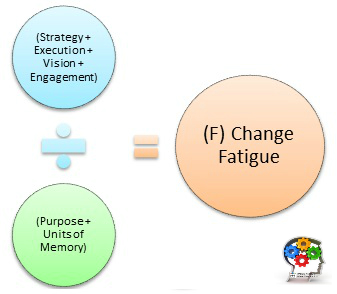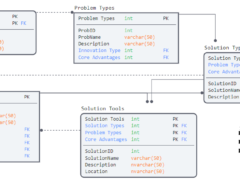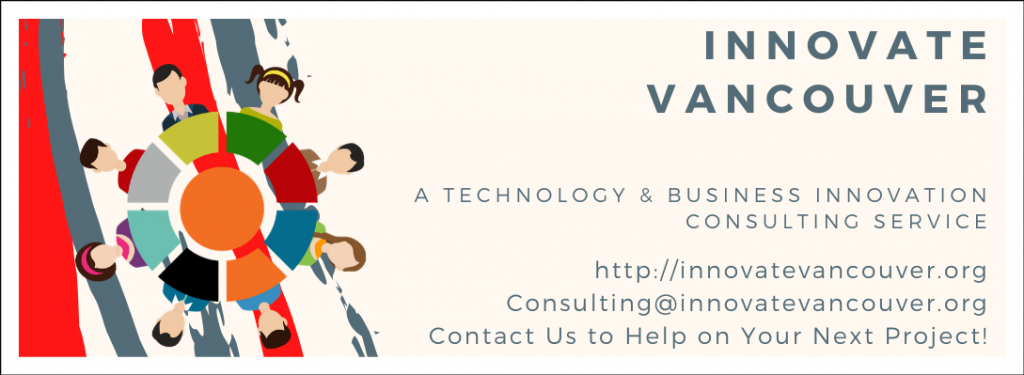Change Fatigue occurs when there is a misalignment between strategy, execution, vision, engagement, and purpose. As alignment decreases the opportunity for change fatigue to set will increase. The sense of purpose becomes fractured as attention becomes distracted and the image of the larger whole disintegrates.

The fracturing of this larger sense of meaning interferes with memory storage and retrieval. Memory formation increasingly fixates on specific remnants of experience and perception. Therefore, the ability to retrieve comprehensive and complex memories decreases. Memory often splinters into discrete and disconnected units. This splintering will interfere with the perception of time and space.
The model enclosed provides a theoretical framework for explaining how change fatigue forms:
- Strategy is defined by the tools and methods by which the team or corporation pursues its goals.
- Execution is defined as the processes and mechanisms by which momentum and progress is both initiated and maintained.
- Vision in the context of this model emphasizes the externally desired goals. The outcomes are pursued either jointly or individually by the team members.
- Engagement in the context of this model involves externally leveraged processes. These include tools and mechanisms that keep employees and teams involved.
- By contrast, Purpose is defined as the internal sense of meaning and value. This is realized by both the individual and the team. They do this in pursuing and contributing to a specific and frequently shared activity.
- Memory becomes crucial towards combating change fatigue as it represents the storage of experience, knowledge, and purpose.
The quality and nature in which memory is formed significantly influence motivation. It also impacts the individual/team’s sense of purpose. Corporate models often support the fragmentation of memory and its retrieval through the following mechanisms that limit complex memory formation and a unifying theory of purpose:
- Hierarchies & Reporting Structures
- Bureaucratic “Red-Tape”
- Functional vs. Team Based Divisions
- Non-Dynamic Job Descriptions
- Ineffective (or Incomplete) Change Management Mechanisms
- Processes, Policies, & Mechanisms that Reinforce Delays, Error Rates, & Omissions
- Barriers to Agile Processes & Flexible Decision Making
- Frequent Strategic Changes, due to Poor Planning, Analysis, and Requirements Gathering up-front

Solving change fatigue requires bridging the gap between the past-present-and-future in the pursuit of a shared vision. Storytelling, corporation celebrations, and traditions that reinforce a sense of meaning and purpose are helpful. They support the joining of memory with the individual’s past-present-and-future purpose.
Addressing the loose-ends is essential. Reconciling the unintended mechanisms that disintegrate a unified sense of purpose and meaning is also critical. These actions become crucial towards combating corporate change fatigue. Planning initiatives that strengthen the individual’s sense of purpose and meaning have multiple benefits. They improve team and cross-department coordination, collaboration, and problem solving.

Being aware of this quasi psycho-strategic calculation is only the first step to resolving corporate change fatigue. Additional strategies can also include:
- Communicating & Celebrating both Start & End Dates on Change Initiatives
- Confirming Roles, Responsibilities, and Action Items
- Supporting Planning & Execution Processes that Incorporate a Systems Approach
- Confirming Requirements, Resources, & Competing Initiatives throughout the Change Management Life-Cycle
- Monitoring Performance Velocity to Insure Expectations do not Exceed Capacity
Change fatigue is not inevitable. It is a result of poor planning and choices made throughout the project (or change management) life-cycle.

Resolving change fatigue does not benefit a ‘one size fits all’ approach. This is because the antecedents leading up to the formation of change fatigue will differ based on the following:
- Culture
- History
- Experience
- Ability
- Traditions & Rituals
- Resources & Tools Available/Used
- Commitment
Notice the characteristics noted above are not just limited to corporations but also extend to people as well. Corporations do not exist without their employees. Therefore, a lack of commitment and engagement at the personal level will impact the larger whole.

Innovation cannot occur in an environment that reinforces change fatigue. Similarly, innovation cannot occur in an environment where memory formation focuses only on the moment. Strategies should not be exclusive to a single context.
The question thus becomes, ‘is change fatigue a function of having a unified sense of purpose?’ Is it also integrated into a complex memory-based system? How can you help your company in different areas? In what ways can you contribute to its improvement? In what ways can you contribute to its improvement? To increase employee resilience to change fatigue?
Travis Barker, MPA GCPM
Innovate Vancouver is a Technology and Business Innovation Consulting Service located in Vancouver, BC. Contact Innovate Vancouver to help with your new project. Innovate Vancouver also gives back to the community through business consulting services. Contact us for more details.




